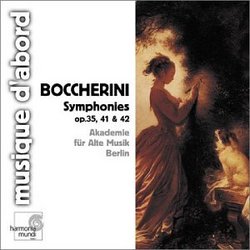| All Artists: Luigi Boccherini, Berlin Akademie für Alte Musik Title: Boccherini: Symphonies, Opp. 35, 41, 42 Members Wishing: 2 Total Copies: 0 Label: Harmonia Mundi Fr. Original Release Date: 1/1/2003 Re-Release Date: 8/12/2003 Album Type: Import Genre: Classical Styles: Historical Periods, Classical (c.1770-1830), Symphonies Number of Discs: 1 SwapaCD Credits: 1 UPC: 794881703722 |
Search - Luigi Boccherini, Berlin Akademie für Alte Musik :: Boccherini: Symphonies, Opp. 35, 41, 42
 | Luigi Boccherini, Berlin Akademie für Alte Musik Boccherini: Symphonies, Opp. 35, 41, 42 Genre: Classical |
Larger Image |
CD DetailsSimilar CDs |
CD ReviewsIn Your Face Boccherini Doug - Haydn Fan | California | 05/22/2008 (4 out of 5 stars) "I've been surveying 18th century music for many years now, and I'm still appalled at how little I have heard and how poor is my and the general understanding of the remarkably wide-ranging music created by the composers who lived during this time.
Boccherini like many of his peers composed an enormous amount of music, and as time goes on it becomes more and more difficult to simply shove it aside as merely perfunctory. Perhaps one of the silver linings to contemporary music's public rejection has been the windfall of attention for these older forgotten composers and their music. In the case of Boccherini's symphonies we now have a complete collection available of all of them. Luigi Boccherini: 28 Symphonies For those not ready for such an investment in relatively uncharted repetoire the option of a single more modestly priced CD symphony sampler must be much the more attractive choice. In this case we have what appears a valid and useful introductory choice, four symphonies which have received (the almost obligatory) praise in the press. Yet the Akademie fur Alte Musik Berlin may not be the best group to introduce you to Boccherini. For starters, they espouse a brutally modern approach, with Boccherini's classic melodic lines often swamped and even obscured by intensive and overly highlighted inner parts playing. Thus, to give just a single instance, in the Minuetto from the 8th symphony G 508, the orchestra members so often unnecessarily insert themselves to the foreground as to finally become a distraction. Over and over I had the feeling this hurdy-gurdy buzzing was not what the composer indicated or desired in the way of emphasis. This produces a barrage of colors and sounds more suitable to television channel switching than listening to elegant music from the 18th century. More importantly, the formal classical outlines and melodies are forever getting lost for the trees - in this case the endless busyness - and it is endless, even relentless - strikes me as precious and 'too look at me', rather than a cohesive amalgamation of musicians working for a larger end. Sadly this cliched style has now become the modus operandi of too many early music groups. There is much to appreciate in the revelations original istruments bring to early music; color and texture most especially. However, when these aspects become more important than the bigger picture and lessen the music's legitmate homegeneity I object. Perhaps this style of performance practice works for you - but I strongly urge a more balanced approach to anyone first hearing Boccherini's symphonies. " |

